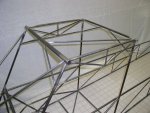Don't be in a hurry to begin construction, on a new design as much of your initial time will be spent in analyzing and refining. If you were to base your build on a tried and tested gyro that has shown in many hours of operation that it is a successful design and you only made cosmetic changes that would be one thing but an all new structure demands proper engineering to be safe.
I asked in a previous post if you had considered how to mount the rotor, that is very important as it will determine load paths within the structure and tubing sizes to carry that load. Also be aware that load paths can be much different in a fuselage that is designed as a strut braced high wing vs a gyro fuselage, depending on how the mast is mounted.
As an example the mast on the LW-5 is attached to the center of a 1"x .049" wall steel tube that crosses the forward cabin roof. The mast is triangulated to the roof sides at four points, the two forward of which attach to plugs which are welded into the ends of the 1" tube and threaded for a bolt. This is one area of concern I have about the LW if one considers that most of the aircraft is hanging on this one welded-in tube, if it fails...........
Now consider what would happen if someone wanted to make a side-by-side LW version and simply widened the fuselage from 26" to 43" without any additional consideration, imagine the resulting tube bending loads.
While tandem seating limits what you can do with mast placement on a tractor given that most of the cabin is filled with occupants and may require mounting the mast to the roof structure on a SxS design there is the possibility of running the mast between the occupants and attaching in other ways, have a look at Mishka's mast mounting.
Design decisions like this must be made first and the structure properly designed around those decisions.
View attachment 1145553View attachment 1145554



